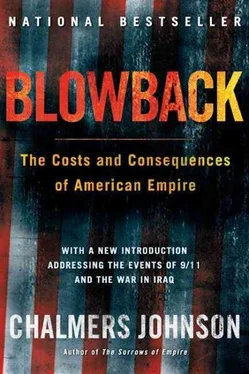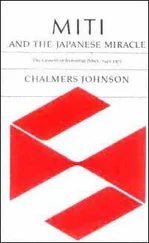Chalmers Johnson - Blowback, Second Edition - The Costs and Consequences of American Empire
Здесь есть возможность читать онлайн «Chalmers Johnson - Blowback, Second Edition - The Costs and Consequences of American Empire» весь текст электронной книги совершенно бесплатно (целиком полную версию без сокращений). В некоторых случаях можно слушать аудио, скачать через торрент в формате fb2 и присутствует краткое содержание. Год выпуска: 0101, ISBN: 0101, Издательство: Macmillan, Жанр: Старинная литература, на английском языке. Описание произведения, (предисловие) а так же отзывы посетителей доступны на портале библиотеки ЛибКат.
- Название:Blowback, Second Edition: The Costs and Consequences of American Empire
- Автор:
- Издательство:Macmillan
- Жанр:
- Год:0101
- ISBN:9780805075595
- Рейтинг книги:5 / 5. Голосов: 1
-
Избранное:Добавить в избранное
- Отзывы:
-
Ваша оценка:
- 100
- 1
- 2
- 3
- 4
- 5
Blowback, Second Edition: The Costs and Consequences of American Empire: краткое содержание, описание и аннотация
Предлагаем к чтению аннотацию, описание, краткое содержание или предисловие (зависит от того, что написал сам автор книги «Blowback, Second Edition: The Costs and Consequences of American Empire»). Если вы не нашли необходимую информацию о книге — напишите в комментариях, мы постараемся отыскать её.
Blowback, Second Edition: The Costs and Consequences of American Empire — читать онлайн бесплатно полную книгу (весь текст) целиком
Ниже представлен текст книги, разбитый по страницам. Система сохранения места последней прочитанной страницы, позволяет с удобством читать онлайн бесплатно книгу «Blowback, Second Edition: The Costs and Consequences of American Empire», без необходимости каждый раз заново искать на чём Вы остановились. Поставьте закладку, и сможете в любой момент перейти на страницу, на которой закончили чтение.
Интервал:
Закладка:
For at least forty-five years after the Cheju massacre, any Korean who so much as mentioned it was liable to arrest by the Korean Central Intelligence Agency (KCIA) or its successors, followed by beatings, torture, and a long prison sentence administered under the terms of the National Security Law, enacted in December 1948 and still on the books in 1998. Only in that year did the director of the Agency for National Security Planning, the KCIA’s successor, promise that abuse of the law for political purposes would stop and Koreans would no longer be arrested for minor violations like praising Communist North Korea. 4Only in 1995, after the arrests of former presidents Chun Doo-hwan and Roh Tae-woo for mutiny, corruption, and murder did the Cheju Provincial Assembly finally feel secure enough to create a committee to investigate the massacre, whose research produced the names of 14,504 victims. The committee’s best estimate of the total killed was thirty thousand, about 10 percent of the island’s population. Some 70 percent of the island’s 230 villages were burned to the ground and a staggering 39,000-plus homes destroyed.
The consolidation of a pro-Soviet regime in North Korea and a pro-American one in South Korea led to a war that began in June 1950. The North Koreans have consistently claimed that this was a war of national liberation against American imperialism, while Americans have generally characterized it as an international conflict in which North Korea invaded South Korea. It was without question a civil war among Koreans, some of whom in the South had collaborated with the Japanese colonialists and some of whom in the North had fought against them. From my personal perspective as a veteran of the period immediately following the armistice of 1953, it was also clearly a war between the United States and China fought on Korean soil.
Shortly after North Korea invaded South Korea on June 25, 1950, the United States intervened in force. In the autumn of that year, after American troops had invaded North Korea, China intervened in force. From June 1950 to early 1951 the war was primarily between U.S. troops and the North Korean army. Starting in March, it became a Sino-U.S. war, and its nature was transformed. The first phase of the war saw massive North Korean, American, and Chinese military movements combined with guerrilla struggles behind the lines. The later Sino-U.S. war bogged down in World War I–style trench warfare along what would later become the Demilitarized Zone (DMZ). Regardless of one’s view of the Korean War, the position of South Korea from the war down to the present has been that of a client of the United States.
In June 1950, the United States took its intervention against the North Korean attack to the U.N. Security Council. The USSR was then boycotting the Security Council to protest an American refusal to allow the new People’s Republic of China to occupy the seat reserved for China. On July 7, 1950, under conditions never again repeated, the Security Council, free of the threat of a Soviet veto, authorized a “unified command under the United States” to defend South Korea. Fifteen nations other than the United States contributed forces to this “unified command.” The United States on its own initiative then created the “United Nations Command” as the operational unit through which it would fight the war. The Republic of Korea also placed its troops under this American-controlled command. Thus, from 1950 to the present, the U.N. commander in Korea was and remains a United States Army general.
The United Nations itself was not, however, a party to the Korean War. There was no U.N. operational control over any aspect of the hostilities, and the United States, the designated occupant of the “unified command,” reported to the United Nations only after the fact. Cynics say that the first U.N. commander, General Douglas MacArthur, never sent the United Nations anything other than his press releases. Under international law the U.N. Command is an alliance of national armies commanded by the United States, even though there are today no other members left except for the United States and South Korea. The armistice agreement of July 27, 1953, was signed by General Mark W. Clark, the U.N. commander; Marshal Kim Il-sung of the Korean People’s Army; and General Peng Dehuai, commander of the Chinese People’s Volunteers—but not by any representative of South Korea. This is one reason why today North Korea insists upon negotiating with the United States, not with South Korea.
Another important result of these arrangements is that the South Korean armed forces—today, some 670,000 men, 461 combat aircraft, and a navy that includes 44 destroyers, frigates, and corvettes as well as 4 attack submarines, with a budget of around US$16 billion—is operationally part of a military command structure headed by an American general. No matter how hard the U.S. government tries to finesse the matter, the South Korean army, except for some elite paratroop and special forces units, is as much under American military control now as it was at the time of the Cheju massacre.
When in 1961 and again in 1979 this South Korean army carried out military coups d’état and in 1980 massacred civilians protesting military rule in the city of Kwangju, ordinary Koreans inevitably saw the Americans as co-conspirators. On November 30, 1994, forty-one years after the armistice and seven years after the birth of Korean democracy, the United States finally transferred peacetime control over South Korean forces to the South Korean Joint Chiefs of Staff. In times of war, however, command reverts to a U.S.-dominated Combined Forces Command. China and Russia today have friendly diplomatic and economic relations with South as well as North Korea, whereas the United States still has 37,000 combat troops occupying 65,500 acres of South Korean territory at 96 bases and has no formal relations with North Korea.
In the years since the Korean War, the United States has had to deal with many difficult situations in its South Korean satellite brought about by popular demands for democracy and independence from the United States, which in many ways resembled the 1956 Hungarian and 1968 Czechoslovak uprisings for democracy and independence from the Soviet Union. The major difference was that whereas the Soviet Union relied primarily on its own armed forces to suppress these popular movements, the United States entrusted repression to the Republic of Korea army, whose leaders ruled South Korea from 1961 to 1993. The most important of these situations was the suppression of the Kwangju uprising of 1980, which bore many similarities to the Hungarian uprising of 1956.
The comparison is instructive. At the end of fascist rule in 1945, the Hungarians tried to establish a popularly supported government. In elections held late in that year, six political parties put up candidates. The Independent Smallholders Party emerged with 245 seats, the Communists with 70, the Social Democrats with 69, and the National Peasants with 23. These four major parties formed a coalition government, but power increasingly flowed to the Communists because of the presence in the country of the Red Army—exactly as happened in South Korea because of the presence of the U.S. Army. By 1948, most non-Communist leaders in Hungary had been silenced, sent into exile abroad, or arrested. In 1949, Hungary officially became a people’s democracy under Matyas Rakosi, a Communist trained in Moscow, who was secretary-general of the Hungarian Workers Party.
Hungary was, of course, not divided into Soviet and American zones. The Allied powers had concluded a peace treaty with Hungary that came into force in September 1947. It called for the withdrawal of all Allied armies except for the USSR’s. Soviet troops were to be stationed in Hungary to maintain lines of communication to Red Army units in the Soviet zone of occupation in Austria. In April 1948, Hungary entered into a treaty of “friendship, cooperation, and mutual assistance” with the USSR in which both parties pledged military assistance to the other if they once again became victims of aggression from Germany or “any state associated with Germany.” The Hungarian army was expanded well beyond the limits authorized in the peace treaty.
Читать дальшеИнтервал:
Закладка:
Похожие книги на «Blowback, Second Edition: The Costs and Consequences of American Empire»
Представляем Вашему вниманию похожие книги на «Blowback, Second Edition: The Costs and Consequences of American Empire» списком для выбора. Мы отобрали схожую по названию и смыслу литературу в надежде предоставить читателям больше вариантов отыскать новые, интересные, ещё непрочитанные произведения.
Обсуждение, отзывы о книге «Blowback, Second Edition: The Costs and Consequences of American Empire» и просто собственные мнения читателей. Оставьте ваши комментарии, напишите, что Вы думаете о произведении, его смысле или главных героях. Укажите что конкретно понравилось, а что нет, и почему Вы так считаете.










